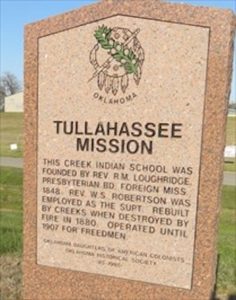
*The Tullahassee Mission was founded on this date in 1850. It was a school in the Creek Nation, Indian Territory of Oklahoma, serving formerly enslaved Black Africans.
While in the Southeast and soon after the Indian Removal Act, most Muscogee Creek opposed all white-American missionaries and their schools. They did not want their traditional culture disrupted by Christianity. In 1842, the Creek Council authorized Presbyterian minister Robert Loughridge to set up a mission in Coweta to get the associated school to educate their children. He founded Koweta Mission after the town in 1843. After assessing this school, the Creek Council allowed Loughridge in 1850 to establish another mission, Tullahassee, northwest of the community of Muskogee.
The Creek covered 20 of the cost from their annuities; the Presbyterian Board of Foreign Missions would cover the rest. Loughridge chose the site for the Tullahassee Mission and purchased 70 acres of land to support the complex. Like other boarding schools, students and staff would raise food and livestock in the facility. A three-story brick building was constructed on the site. For the next three decades, it was operated as an Indian boarding school to train both "full-blood" and "mixed-blood" Muscogee students. The latter generally had some European ancestry and were often descendants of traders who had married into the tribe in previous decades.

After the American Civil War, the community of Tullahassee had become increasingly settled by descendants of Creek Freedmen, and the number of Muscogee had declined. The Muscogee gave the Tullahassee mission and community to the Creek Freedmen, and it is one of the few surviving all-Black towns in the state. The Muscogee paid to replace the damaged main Tullahassee building. The Muscogee children went to the Wealaka Mission in 1881. The tribal leaders turned over the former mission building to Creek freedmen on October 24, 1881. The school reopened in 1883 for Creek Freedmen and their descendants as Tullahassee Manual Labor School. The Baptist Home Mission Society contributed additional funding. The freedmen incorporated the town in 1902 and recruited more Black freedmen from the South as settlers.
Much of the Creek lands went to households by the early 20th century. In 1906, to extinguish tribal land claims and organization in preparation for Oklahoma to be admitted as a state, the federal government dissolved Creek institutions, including its school system. Tullahassee Manual Labor School was the only school in the former Creek Nation to remain temporarily open for descendants of Creek freedmen and other Blacks. In 1908, the U.S. government took over ownership of the site via the United States Department of Interior and sold the property in 1914 to Wagoner County, Oklahoma, for local uses. In 1916, the African Methodist Episcopal Church founded Flipper-Key-Davis College in Tullahassee. It was permitted to use the former mission building for the school.
This was the only private school for higher education for Blacks in Oklahoma at the time. The College closed at the end of the 1935 school year, during the Great Depression when many institutions had financial difficulties. An informal sign marks the Tullahassee Creek Indian Cemetery, established in 1883 near the mission site. In the 21st century, the small community of Tullahassee is considered the oldest of the thirteen surviving all-Black towns in the former Indian Territory.